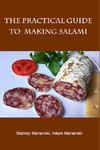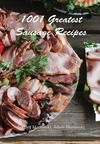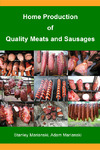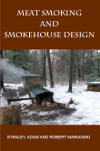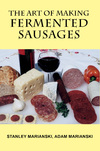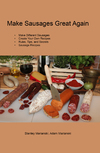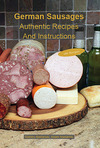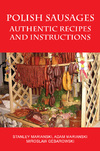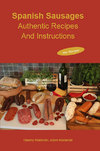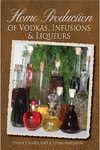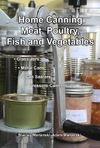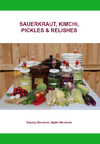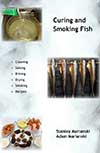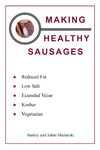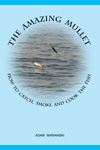Meats and Sausages
Curing Meats for Smoking
The best quality smoked meats and sausages are made from cured meat. Fresh sausages, blood sausages, and liver sausages are usually made from uncured meat, although some meats, such as tongues for head cheeses, are cured to make them pink and more visible. The general rule, however, remains the same: meats that will be smoked should be cured first. Curing meat not only develops a pink color, but more importantly, it develops a characteristic curing flavor in smoked meats.
Some of the meat cuts listed below might not available for a hobbyist, however, a farmer who slaughters his own animals will definitely find the information useful.
Dry Curing and Salting
The cuts that don't contain meat (and myoglobin), such as back fat or fat trimmings, are cured with salt only. Sodium nitrite reacts with myoglobin (meat) so it will be wasted when added to fat. In addition, the customer will have to eat it.
| Name | Dry curing mix (salt and sodium nitrite) | Salt | Curing time |
|---|---|---|---|
| Smoked jowl | Curing mix for 1 kg (2.2 lb) jowls: 70 g salt and 2.0 g Cure #1(1/2 tsp). |
- | 12-15 days |
| Smoked back fat | - | 7% | 14-18 days |
| Smoked horse loin | Curing mix for 1 kg (2.2 lb) horse loin: 30 g salt, 2.5 g cure # 1, 10 g sugar. |
- | 10-12 days |
Salting Back Fat for Smoking
Back fat should be as thick as possible, 1.5 inch (30 mm), including the skin. There is no need for adding nitrite/nitrate as backfat does not contain meat and myoglobin. There is nothing for the nitrite to react with.
About 7% salt total is used in relation to the weight of back fat (70 g salt for 1 kg of back fat). The salt is applied in two stages: 50 g (5%) of salt is rubbed into 1 kg of back fat. Some salt is sprinkled on the bottom of the container; then, back fat is placed the skin down. Then the second back fat goes on top (skin down) etc. The top back fat is placed on the skin up and some salt is sprinkled on top.
After 7 days, the stacking order is reversed; the top pieces go down and the bottom fat backs go up. This step adds 2% more salt (20 g per 1 kg of back fat). Back fat remains in salt for 7 days or more. The total time is 2-3 weeks.
Curing Jowls for Smoking
The cross-section of jowl looks like bacon; the difference is that jowls are much tougher due to more connective tissue. Having more collagen, they produce natural gelatin, which helps bind different ingredients together, for example, groats or bread crumbs with meat. For this reason, they are added to special sausages such as head cheeses, blood and liver sausages.
As jowl contains layers of meat, sodium nitrite is added with salt to develop curing flavor and pink color. To cure 1 kg of jowls use 50 g salt (5%) and 0.02% (2.0 g) of Cure #1 which contains sodium nitrite.
Mix 7% (70 g) of salt with 0.02% (2 g) of Cure #1 per 1 kg of jowls. The mixture of salt and Cure #1 is applied in two stages: 50 g (5%) of the mixture is rubbed in into 1 kg of jowls. Some mixture is sprinkled on the bottom of container, then first jowl is placed the skin down. Then the second jowl goes on top (skin down) etc. The top jowl is placed the skin up and some salt is sprinkled on top.
After 7 days, the stacking order is reversed; the top pieces go down, and the bottom jowls go up. During this step 2% more mixture (20 g per 1 kg of jowls) is added. Jowls remain in salt for 7 days more. The total time 2 weeks.
Wet Curing
Meats are placed in a container, secured on top with a screen to submerge them, and covered with curing solution (water, salt and sodium nitrite). In the USA Cure #1 (sodium nitrite and salt) will be used. In other countries different strength sodium nitrite cures are available. Making Brine...
Making brine using tables is the first step of making a curing solution. The next step is adding sodium nitrite, usually premixed with salt and known as Cure #1. Adding very little will result in a weaker curing flavor and color, adding too much will push us over the maximum limits which were establish by the Food and Drug Administration. The following tables were created in 1969-1970s and potassium nitrate was used as curing agent. Nitrates are seldom use today, and sodium nitrite is a universally accepted curing agent. It is hard to find potassium nitrate today, at least for a hobbyist. To make the tables easier to use, the most popular curing solutions were calculated with Cure #1.
| Curing Solutions | ||||||||
|---|---|---|---|---|---|---|---|---|
| Strength in ° SAL | 25° | 27° | 35° | 46° | 54° | 60° | 69° | 80° |
| Water, US Gallon (3.8 l) |
1 | 1 | 1 | 1 | 1 | 1 | 1 | 1 |
| Salt | 5.43 oz (154 g) | 6.25 oz (177 g) | 9.6 oz (272 g) | 14.4 oz (410 g) | 1.13 lb (515 g) | 1.32 lb (598 g) | 1.60 lb (728 g) | 1.98 lb (898 g) |
| Cure # 1 | 4.2 oz (120 g) | 4.2 oz (120 g) | 4.2 oz (120 g) | 4.2 oz (120 g) | 4.2 oz (120 g) | 4.2 oz (120 g) | 4.2 oz (120 g) | 4.2 oz (120 g) |
| Salt in Cure # 1 accounted for. 120 g Cure # 1 contains 112.5 g of salt. Making Curing Solutions Brine Tables |
||||||||
Example: To make one gallon of 46° SAL curing solution you need to mix 14.4 oz of salt, 4.2 oz of Cure #1 and 1 gallon of water.
| Name | Curing solution in °Bé (Europe) | Curing solution in °SAL (USA) | The amount (%) of curing solution per weight of meat | Curing time in days | Draining time in hours |
|---|---|---|---|---|---|
| Pork tongues | 14 | 54 | 40% (400 g solution per 1 kg of meat) | 5-6 | 12 |
| Veal tongues | 14 | 54 | 40 | 5-6 | 12 |
| Beef tongues | 14 | 54 | 40 | 14-31 | 12 |
| Sheep tongues | 14 | 54 | 40 | 5-6 | 12 |
| Pork hearts | 14 | 54 | 40 | 3-4 | 12 |
| Veal hearts | 14 | 54 | 40 | 3-4 | 12 |
| Beef hearts | 14 | 54 | 40 | 4-5 | 12 |
| Sheep hearts | 14 | 54 | 40 | 3-4 | 12 |
| Pork heads | 16 | 60 | 60 | 4-6 | 4-12 |
| Veal heads | 14 | 54 | 60 | 3-4 | 4-12 |
| Beef heads | 14 | 54 | 60 | 3-4 | 4-12 |
| Sheep heads | 14 | 54 | 60 | 3-4 | 4-12 |
| Pork ears | 16 | 60 | 40 | 2 | 12 |
| Pig feet | 16 | 60 | 60 | 2-4 | 12 |
| Veal lips | 16 | 60 | 40 | 4-5 | 4-12 |
| Pork masks | 14 | 54 | 40 | 3-4 | 12 |
| Curing solution: water, salt, sodium nitrite. Curing temperature 40-46° F (4-8° C). | |||||
| Name | Curing solution in °Bé (Europe) | Curing solution in °SAL (USA) | The amount (%) of curing solution per weight of meat | Curing time in days |
Draining time in hours |
|---|---|---|---|---|---|
| Smoked pork hocks | 16-18 | 60-69 | 60% (600 g solution per 1 kg of meat) | 3-4 | 12 |
| Smoked ribs | 12-14 | 46-54 | 40 | 3-5 | 12 |
| Smoked hocks | 14-16 | 54-60 | 40 | 5-10 | 12 |
| Smoked beef tongues | 14-16 | 54-60 | 40 | 14-20 | 12 |
| Baked pork tender loins | 6-7 (sugar also added) | 25-27 | 50 | 2-3 | 4-6 |
Combination Curing - Injection Method Followed by Immersion Method
Meats are injected and then immersed in a curing solution. If the solution contains fresh herbs and spices, the meat should be injected with salt and nitrite first and the spices should be added to the curing solution. Otherwise, the needles can become clogged.
| Name | Curing solution in °Bé (Europe) | Curing solution in °SAL (USA) | The percentage of total curing solution used for injections | Number of injections (muscles) | The amount (%) of curing solution per weight of meat | Curing time in days | Draining time in hours |
|---|---|---|---|---|---|---|---|
| Pork ham, smoked and cooked in water | 16-18 | 60-69 | 6-7% | 7-9 | 40% (400 g solution per 1 kg of meat) | 8-12 | 48 |
| Pork butt, smoked and cooked in water | 16-18 | 60-69 | 6-7 | 5-7 | 40 | 6-10 | 48 |
| Veal ham, cooked in water | 16-18 | 60-69 | 5-6 | 4-5 | 40 | 7-12 | 24 |
| Pork loin, baked | 7-9 | 27-35 | 3-4 | 4-5 | 40 | 1 | 12 |
| Beef loin, smoked | 12 | 46 | 2 | 2 | 30 | 6-8 | 24 |
| Beef ham, smoked and cooked in water | 16-18 | 60-69 | 6-7 | 2-4 | 30 | 8-10 | 48 |
Mixed Curing
Procedure: rub dry curing mix into the meat all around. Place in a container, covering each piece with more salt. Pieces with skin are placed the skin side down. Cure for 14 hours and then cover with wet curing solution and cure for 1-2 days.
| Name | The amount of dry curing mix (%) per weight of meat | Dry curing in hours | Curing solution in °Bé (Europe) | Curing solution in °SAL (USA) | The amount (%) of wet curing solution per weight of meat | Wet curing in days | Draining time |
|---|---|---|---|---|---|---|---|
| Smoked loin | 2% (20 g per 1 kg of meat) | 24-36 | 12-14 | 46-54 | 30% (300 g solution per 1 kg of meat) | 5-8 | 24 hrs |
| Smoked butt | 2-6 | 24-36 | 12-14 | 46-54 | 30 | 6-10 | 24 hrs |
| Butt, cooked in water | 2-6 | 24-36 | 12-14 | 46-54 | 30 | 6-10 | 24 hrs |
| Smoked bacon | 3 | 24-36 | 14-16 | 54-60 | 40 | 7-10 | 1-2 days |
| Bacon, cooked in water | 3 | 24-36 | 14-16 | 54-60 | 40 | 7-10 | 1-2 days |
| Curing mix for 1 kg (2.2 lb) of meat: 30 g salt, 2.5 g cure # 1, 10 g sugar. | |||||||
Brine Curing
| Name | Brine in °Bé | Brine in °SAL | Brining time in hours |
|---|---|---|---|
| Pork skins, beef udders and tripe, veal tripe, pork stomachs (inside slime removed) | 12-14 | 54-60 | 48-72 |
| Brine: salt and water. Curing temperature 40-46° F (4-8° C). | |||
Submerge meats in brine. Drain.
Special Applications
Salting Back Fat
Back fat does not need to be smoked, it can be just salted. After 3 weeks of salting back fat softens and can be eaten; it has been a popular snack in the past.
Back fat is salted using 7-8% salt in relation to the weight of back fat. This corresponds to 70-80 g salt per 1 kg of back fat.
5% salt is used for rubbing.
3% salt is used for sprinkling.
Rub in salt into each piece of back fat on all sides using 5% of salt. Use remaining salt (3%) for sprinkling the bottom of the container (about 1/4 inch, 6 mm) and the top of the pile. Salting time 14-21 days depending on the thickness of fat backs. After 7 days you can reverse the stacking order; the top pieces go down and the bottom fat backs go up.
Salting Small Fat Trimmings
Fat trimmings are salted taking 2% salt in relation to the weight. Mix fat trimmings thoroughly with salt and place in a container for 24-48 hours.
Blood
Fresh blood is usually salted with 3% salt in relation to the weight, but sodium nitrite may also be added. Blood can be kept up to 48 hours at 40° F (4° C). It can be frozen for longer storage.

